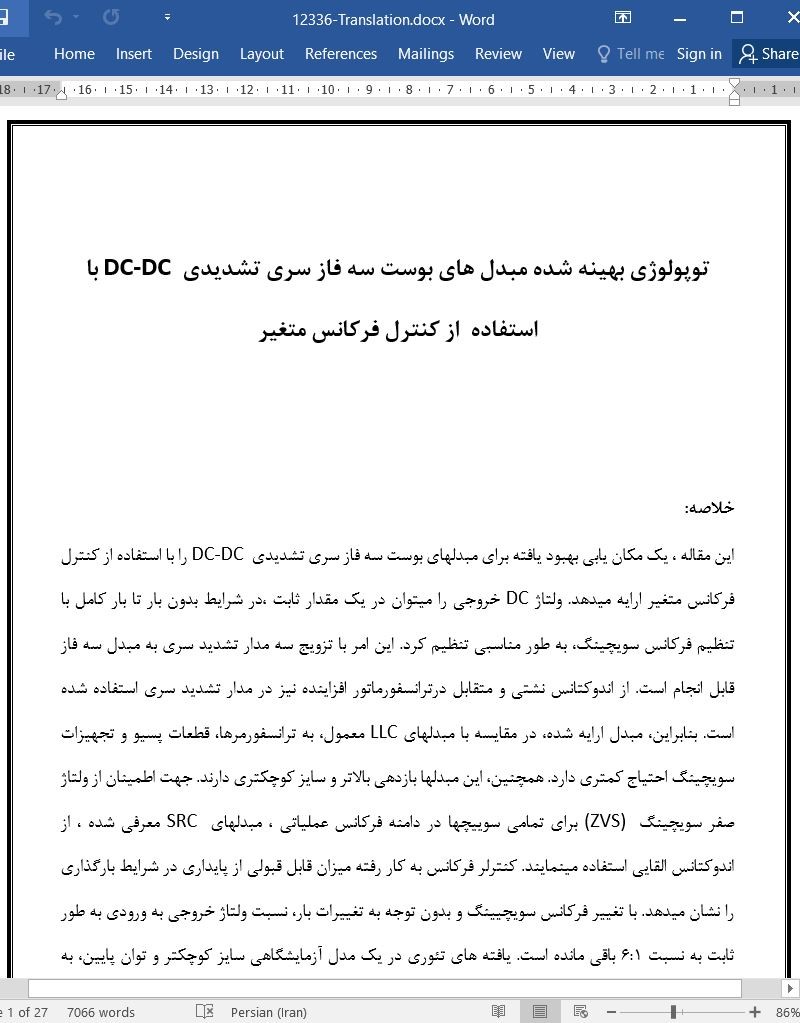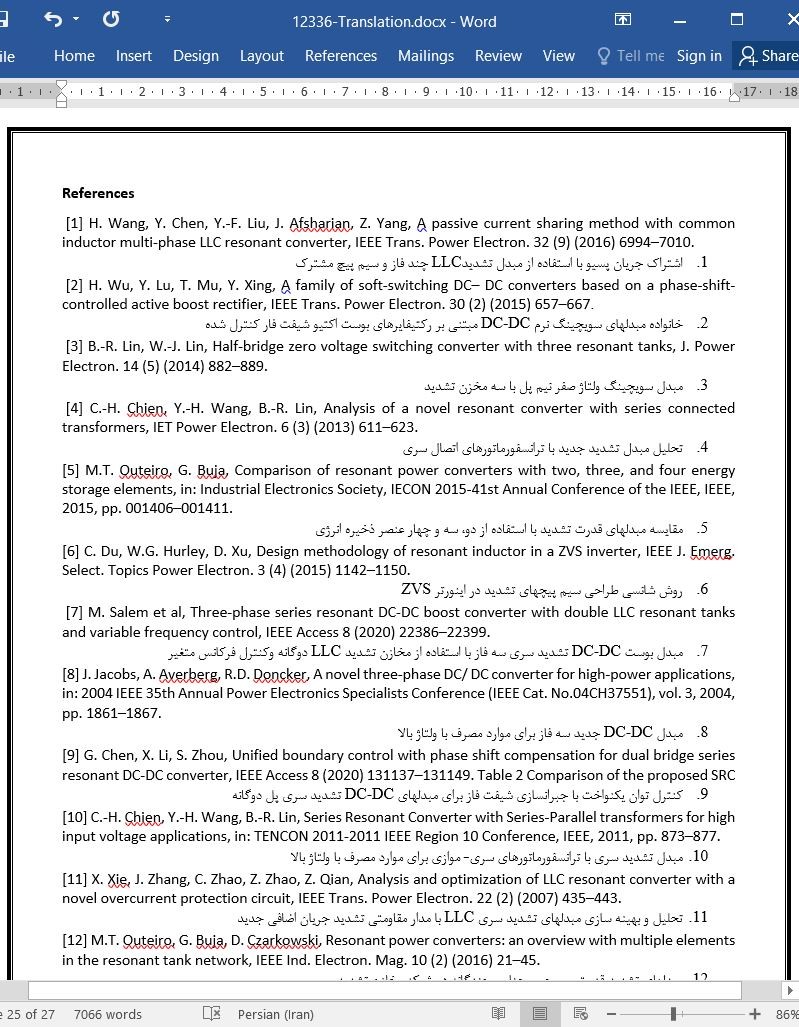
توپولوژی بهینه شده مبدل های بوست سه فاز سری تشدیدی DC-DC
خلاصه
این مقاله ، یک مکان یابی بهبود یافته برای مبدلهای بوست سه فاز سری تشدیدی DC-DC را با استفاده از کنترل فرکانس متغیر ارایه میدهد. ولتاژ DC خروجی را میتوان در یک مقدار ثابت ،در شرایط بدون بار تا بار کامل با تنظیم فرکانس سویچینگ، به طور مناسبی تنظیم کرد. این امر با تزویج سه مدار تشدید سری به مبدل سه فاز قابل انجام است. از اندوکتانس نشتی و متقابل درترانسفورماتور افزاینده نیز در مدار تشدید سری استفاده شده است. بنابراین، مبدل ارایه شده، در مقایسه با مبدلهای LLC معمول، به ترانسفورمرها، قطعات پسیو و تجهیزات سویچینگ احتیاج کمتری دارد. همچنین، این مبدلها بازدهی بالاتر و سایز کوچکتری دارند. جهت اطمینان از ولتاژ صفر سویچینگ(ZVS) برای تمامی سوییچها در دامنه فرکانس عملیاتی ، مبدلهای SRC معرفی شده ، از اندوکتانس القایی استفاده مینمایند. کنترلر فرکانس به کار رفته میزان قابل قبولی از پایداری در شرایط بارگذاری را نشان میدهد. با تغییر فرکانس سویچیینگ و بدون توجه به تغییرات بار، نسبت ولتاژ خروجی به ورودی به طور ثابت به نسبت 6:1 باقی مانده است. یافته های تئوری در یک مدل آزمایشگاهی سایز کوچکتر و توان پایین، به طور عملی تایید شده اند. با استفاده از نتایج به دست آمده، عملکرد مبدل ارایه شده( بر اساس مقدار بازدهی آن) تایید شده است.
1- مقدمه
نیاز به انرژیهای پاک در سیستمهای قدرت، با افزایش موارد مصرف صنعتی از قبیل، شبکه های انتقال هوشمند، خودروهای برقی و سیستمهای انرژیهای تجدید پذیر همراه شده است که این امر منجر به تقاضای روزافزون مبدلهای تشدیدی DC/DC شده است. این مبدلهای تشدید در فرکانسهای عملیاتی بالا دارای مزایایی از قبیل سویچینگ نرم، شکل موجهای هموار و بازدهی بالا هستند[1,3]. مزیت بدون چون و چرای سویچینگ نرم این امکان را به مبدل می دهد که حتی در هنگام کار در فرکانسهای بالای سویچینگ تلفات کاهش یابد. [4,6] طبقه بندی رفتار مبدلهای تشدیدی به عوامل مختلفی از قبیل روشهای سویچینگ ، ضریب فرکانس و حالت عملیاتی بستگی دارد. یک مبدل در صورتیکه بتواند به فرکانس سویچینگی بیشتر از فرکانس تشدید برسد، میتواند به مرحله جابه جا گری ZVS برای تمامی سویچها برسد[7]. به بیان دیگر، فرکانس تشدید بالاتر از فرکانس سویچینگ میتواند به سویچینگ جریان صفر(ZVC) منجر شود[8,9]. مبدلهای تشدید سری (ZRC) به دلیل سهولت استفاده موارد مصرف بسیاری دارند[10,11].
6- نتیجه گیری
در این مطالعه ، مخازن تشدید سری سه فاز SRC با کنترل فرکانس متغیر پیشنهاد شده بودند. این مبدل مفهومی، دربرگیرنده ویژگیهای مشخصی به شرح زیر می باشد: (a) در مقایسه با مبدل تشدید سه فاز LLC درهم تنیده ، این مدل پیشنهادی تعداد کمتری سوییچ استفاده می نمود. این امر کاهش محسوسی در کاهش وزن، قیمت پایینتر و مدار ساده تر خواهد داشت. (b) القا کنایی مغاطیسی ترانسفورماتور دامنه وسیعی از ZVS فراهم نموده و که در آن ZVS می تواند در کل دامنه عملیاتی فرکانس و هر سوییچ می تواند بوسیله مدل پیشنهادی قابل دستیابی می باشد. (C) ولتاژ خروجی مبدل پیشنهادی، شش برابر ولتاژ خروجی می باشد. این نشان دهنده مناسب بودن این مبدل برای استفاده در موارد مصرفی با ولتاژ بالا می باشد. (d) با استفاده از مبدل پیشنهادی، می تواند از کنترل فرکانس سویچینگ استفاده و تغییرات گسترده بار را حفظ نمود. از آنجایی که این مدل پیشنهادی تکیه زیادی بر روی فرکانس سویچینگ تشدید ندارد، میتوان دید که ضریب بار، به طور جدی بر روی بهره تاثیر نمیگذارد.
Abstract
This paper proposes an improved topology of the three-phase series resonant DC-DC Boost converter with variable frequency control. The DC output voltage can be properly regulated at a constant value from no-load condition to full-load condition by adjusting the switching frequency. This is feasible with the three series resonant circuits coupled to the three-phase inverter. The leakage and mutual inductances of the step-up transformer are used implicitly in the series resonant circuits. Therefore, the proposed converter, when matched to the traditional three-phase inter-leaved LLC converters, requires fewer transformers, passive components, and switching devices. Furthermore, it offers better efficiency and size reduction. The proposed SRC converter also relies on the transformer’s magnetizing inductance to ensure zero voltage switching (ZVS) for all the switches within the considered range of the operating frequency. The deployed variable frequency controller shows a good level of stability at the considered loading conditions. The output voltage-to-input voltage ratio is steadily regulated at 6:1, irrespective of the load variation, by varying the switching frequency. The experimental validation of the theoretical findings proceeded on a low power scaled-down laboratory prototype. From the achieved results, the performance of the proposed converter (in terms of its effectiveness) was validated.
1. Introduction
The recent drive for clean energy in power systems, coupled with the increasing industrial applications, such as in smartgrids, electric vehicles, and renewable energy systems, has led to a substantial interest in DC/DC resonant converters. These resonant converters have the advantages of high-frequency operations with soft switching, smooth waveforms, highpower density, and high-efficiency [1–3]. The soft switching merit undoubtedly allows the converter to experience reduced switching losses, even when operating at a high switching frequency [4–6]. The classification of the behavior of resonant converters might depend on many variables, such as their switching technique, frequency ratio, and mode of operation. A converter can achieve ZVS commutation for all switches if it achieves a higher switching frequency than the resonant frequency [7]. Alternatively, a higher resonant frequency than the switching frequency results in zero current switching (ZCS) [8,9]. Series resonant converters (SRC) are popular for many applications due to their simplicity [10,11].
6. Conclusion
In this study, a three-phase series resonant tanks SRC with variable frequency control was proposed. This conceptualized converter contains certain attributes, as follows: (a) in comparison to the three-phase interleaved LLC resonant converter, the suggested converter might decrease how many power switches. are needed. This would have a major influence, enabling weight reduction, lower cost, and a simpler circuit. (b) The utilized transformers’ magnetizing inductance provide a broad ZVS range, within which the ZVS for the entire operating range of frequency and for every switch could be achieved by the suggested converter. (c) The suggested converter’s output voltage is a six-fold increase over the input voltage. This indicates the suitability of the suggested converter for applications of high voltage. (d) With the suggested converter, variable switching frequency control was utilized and a wide load variation was maintained. This give confirmation that the load factor does not strictly affect any gain, since there is heavy reliance on the ratio of switching to resonant frequency.
خلاصه
1- مقدمه
2- توپولوژی و مشخصات مبدل پیشنهادی
2.1- پیکربندی مدار مبدل پیشنهادی
2.2- مشخصات مدار
3- قواعد عملکرد
3.1- حالت 1 t0<t<t1
3.2- حالت 2 (t1<t<t2)
3.3- حالت 3 (t2<t<t3)
3.4- حالت 4 (t3<t<t4)
3.5- حالت 4 (t4<t<t5)
3.6- حالت 6 (t5<t<t6)
3.7 - حالت 7 (t6<t<t7)
4 – پارامترهای مدار
5- نتایج تجربی
6- نتیجه گیری
منابع
Abstract
1. Introduction
2. Proposed converter topology and characteristics
2.1. Circuit configuration of the proposed converter
2.2. Circuit characteristics
3. Principle of operation
3.1. Mode 1 t0<t<t1
3.2. Mode 2 (t1<t<t2)
3.3. Mode 3 (t2<t<t3)
3.4. Mode 4 (t3<t<t4)
3.5. Mode 5 (t4<t<t5)
3.6. Mode 6 (t5<t<t6)
3.7. Mode 7 (t6<t<t7)
4. Circuit parameters
5. Experimental results
6. Conclusion
References
- اصل مقاله انگلیسی با فرمت ورد (word) با قابلیت ویرایش
- ترجمه فارسی مقاله با فرمت ورد (word) با قابلیت ویرایش، بدون آرم سایت ای ترجمه
- ترجمه فارسی مقاله با فرمت pdf، بدون آرم سایت ای ترجمه



